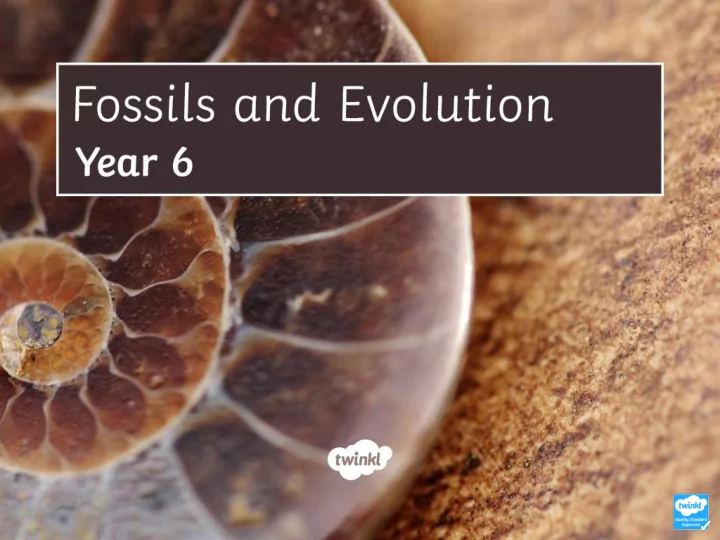

Learning Objective Aim • To understand how fossils can be used to give us information about living things that lived many years ago. Success Criteria Success Criteria • Statement 1 Lorem ipsum dolor sit amet, consectetur adipiscing elit. • To simply describe how fossils are formed. • Statement 2 • To know that fossils are evidence for evolution. • Sub statement
Recap Can you remember what is meant by these words? Inheritance Adaptation Evolution
What is a Fossil? Fossils are the stone remains of dead animals or plants. Fossils are usually the skeletons of animals and plants but not always. Fossils can also be things made by animals like footprints or poo!
What is a Fossil? The most common way that fossils are formed is when small animals like flies and spiders get covered by tree sap they get trapped. The tree sap hardens to form solid amber, preserving them for thousands of years. Photo courtesy of Walraven (@flickr.com) - granted under creative commons licence - attribution
What is a Fossil? Sometimes a whole animal can get trapped in ice, freezing them for thousands of years. Palaeontologists (people who study fossils) have found woolly mammoths that have been preserved this way.
How are Fossils Made? Ice is excellent at preserving whatever may be frozen in it. A mammoth thought to be about 10,000 years old, recently discovered in Siberia, was preserved so well in the ice that the carcass still contained some of its blood. Scientists analysed the blood and found that the mammoth had evolved so that it’s blood could supply more oxygen around its body which is vital in icy climates. This is something that modern elephants (which are related to mammoths) cannot do. Photo courtesy of quinet (@flickr.com) - granted under creative commons licence - attribution
Demonstration: How is a Fossil Made? An animal or creature dies. Its remains get covered in mud and dirt over time.
Demonstration: How is a Fossil Made? Over thousands of years, pressure builds up from all the layers of rock and mud covering the skeleton. The skeleton is dissolved by ground water. This makes a perfect mould of the skeleton.
Demonstration: How is a Fossil Made? Minerals in the ground water begin to fill the mould of the skeleton. These minerals form rock within the mould (this takes at least 10,000 years).
Demonstration: How is a Fossil Made? Finally all that’s left is a perfect fossilised skeleton. Over time, the layers of rock and earth erode away leaving the fossil to be found.
Fossils and Evolution Fossils are For example, very useful for palaeontologists telling us think that these more about fossil skeletons how animals show how and plants whales might have evolved originate from over time. land animals.
Activity Whose bones are they anyway? Your task is to try and find out which fossilised bones belong to which dinosaur. Use the shape, structure and size of the fossil bones to explain each match you find.
Activity Can you predict which dinosaurs are carnivores (meat eaters) and which ones are herbivores (plant eaters)? How can you tell?
Plenary What are the three main ways that fossils are formed? What can fossils tell us?
Recommend
More recommend